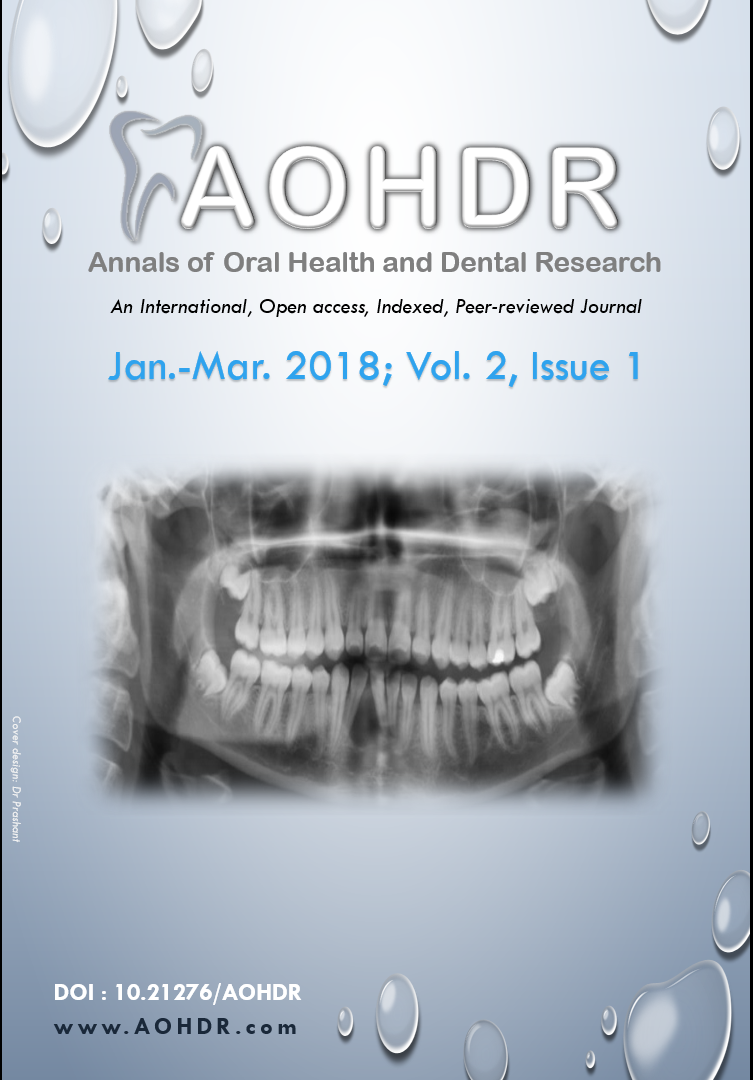The conventional prowess termed hemisection: 2 case reports
Keywords:
Hemisection, Resection, Furcation involvement, Endodontic mishap
Abstract
Hemisection is a logical surgical option for treatment of a seemingly hopeless mandibular molar. Being a suitable alternative to extraction and implant therapy, it should be informed to each patient whenever indicated. The conservative demands have increased in dental practice and so have the pathological resorptions, root fractures and procedural accidents in endodontics. One case presented here was treated for furcation pathology and the other is reported with endodontic over instrumentation. A Perio- Prosthodontic management is demonstrated in both situations with an acceptable prognosis. For the reason that periodontal problems around resected molars have a tendency to recur, a sound diagnosis combined with a prudent case selection is a must. DOI:10.21276/AOHDR.1885References
1. Pontoriero R, Lindhe J. Guided tissue regeneration in the treatment of degree III furcations in maxillary molars. J Clin Periodontal 1995; 22; 810-812.
2. Kost WJ, Stakiw JE. Root amputation and hemisection. J Can Dent Assoc. 1991;57 (1):42-5.
3. Saad MN, Moreno J, Crawford C. Hemisection as an alternative treatment for decayed multirooted terminal abutment: a case report. J Can Dent Assoc. 2009; 75: 387-90.
4. Siqueira JF Jr. Aetiology of root canal treatment failure: why well treated teeth can fail. Int Endod J 2001;34 (1):1-10.
5. Northway WM. The nuts and bolts of hemisection treatment: managing congenitally missing mandibular second premolars. Am J Orthod Dentofacial Orthop. 2005; 127: 606-10.
6. Abdallah F, Kon S, Ruben MP. The furcation problem: etiology, diagnosis, therapy and prognosis. J West Soc periodontal 1987; 35: 129-41.
7. Buhler H. Survival rates of hemisected teeth: an attempt to compare them with survival rates of alloplastic implants. Int J Periodontics Restorative Dent. 1994;14: 536-43.
8. Fugazzotto PA. A comparison of the success of root resected molars and molar position implants in function in a private practice: results of up to 15-plus years. J Periodontol. 200; 72: 1113-1123.
9. Green EN. Hemisection and root amputation. J Am Dent Assoc 1986; 112: 511-18.
10. Zafiropoulos GG, Hoffmann O, Kasaj A, Willershausen B, Deli G, Tatakis DN. Mandibular molar root resection versus implant therapy: a retrospective nonrandomized study. J Oral Implantol. 2009;35: 52-62.
2. Kost WJ, Stakiw JE. Root amputation and hemisection. J Can Dent Assoc. 1991;57 (1):42-5.
3. Saad MN, Moreno J, Crawford C. Hemisection as an alternative treatment for decayed multirooted terminal abutment: a case report. J Can Dent Assoc. 2009; 75: 387-90.
4. Siqueira JF Jr. Aetiology of root canal treatment failure: why well treated teeth can fail. Int Endod J 2001;34 (1):1-10.
5. Northway WM. The nuts and bolts of hemisection treatment: managing congenitally missing mandibular second premolars. Am J Orthod Dentofacial Orthop. 2005; 127: 606-10.
6. Abdallah F, Kon S, Ruben MP. The furcation problem: etiology, diagnosis, therapy and prognosis. J West Soc periodontal 1987; 35: 129-41.
7. Buhler H. Survival rates of hemisected teeth: an attempt to compare them with survival rates of alloplastic implants. Int J Periodontics Restorative Dent. 1994;14: 536-43.
8. Fugazzotto PA. A comparison of the success of root resected molars and molar position implants in function in a private practice: results of up to 15-plus years. J Periodontol. 200; 72: 1113-1123.
9. Green EN. Hemisection and root amputation. J Am Dent Assoc 1986; 112: 511-18.
10. Zafiropoulos GG, Hoffmann O, Kasaj A, Willershausen B, Deli G, Tatakis DN. Mandibular molar root resection versus implant therapy: a retrospective nonrandomized study. J Oral Implantol. 2009;35: 52-62.
Published
2018-03-24
Issue
Section
Case Reports
Authors who publish with this journal agree to the following terms:
- Authors retain copyright and grant the journal right of first publication with the work simultaneously licensed under a Creative Commons Attribution License that allows others to share the work with an acknowledgement of the work's authorship and initial publication in this journal.
- Authors are able to enter into separate, additional contractual arrangements for the non-exclusive distribution of the journal's published version of the work (e.g., post it to an institutional repository or publish it in a book), with an acknowledgement of its initial publication in this journal.
- Authors are permitted and encouraged to post their work online (e.g., in institutional repositories or on their website) prior to and during the submission process, as it can lead to productive exchanges, as well as earlier and greater citation of published work (See The Effect of Open Access).


